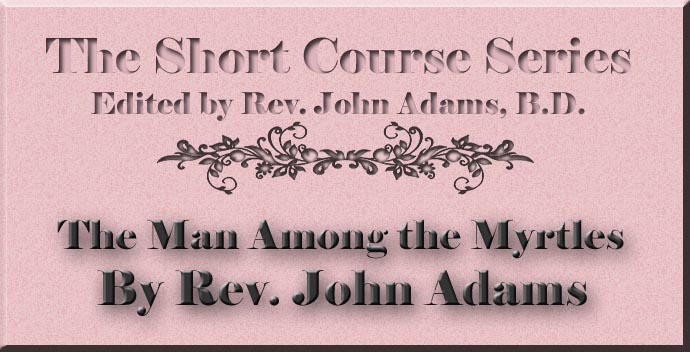
THE SHORT COURSE SERIES
Edited by Rev. John Adams, B.D.
The Man Among the Myrtles
A STUDY IN ZECHARIAH’S VISIONS
By Rev. John Adams, B.D.
Warning: the Author holds to the Liberal Wellhausen's Documentary Hypothesis view of Scripture that rejects the view that God is big enough to predict the future. The author still as some good things to say but all of his mentions of the Deutero-Isaiah lie must be rejected by any REAL CHRISTIAN.
Appendix
The Value of ExpositionA strong reaction in the direction of revived Bible study is "one of the great desiderata of our times." So writes one of the ablest of our present-day teachers, and all the signs seem to suggest that he is right. The hour has arrived for a frank presentation of the positive elements of divine revelation, and for a candid recognition of the fact that the time of reconstruction has come. This reaction ought to be cordially welcomed and encouraged. In addition to all our reading about the Bible — its origin, its history and its inspiration — we shall do well to read a good deal more in it, and show through all the avenues of modern education what are its true contents and character. It may easily happen that for the Church of the future there is a great spiritual uplift along this path. God will honour His word if we do. Only let the practical aspects of the subject be duly emphasised, and the motto of each student be—
This, however, must imply a first-hand acquaintance with the text. The exposition desiderated has to be true to all the criteria of Bible interpretation as known to modern scholarship. Hebrew syntax, Septuagint Greek, New Testament synonyms and Hebraic figures of speech are all needed for a due appreciation of the Sacred Writings; and there will be no powerful reaction in the direction of fresh Bible study until these practical aspects of grammar and Hebrew style are intelligently grasped and utilised. It is from this point of view that the foregoing studies in Zechariah's visions have been written. At every step they have sought to keep in touch with the text. They have been based, first and chief, on the wealth of information contained in the Oxford Hebrew Lexicon, and on the suggestive and luminous footnotes in Kittel'8 Hebrew Bible. If, in addition to these, the author were asked to tabulate the six best helps, among easily accessible literature, for the preparation of similar lectures on "The Man among the Myrtles," he might specify the following: — Zechariah and his Prophecies, by C. H. H. Wright. This was the Bampton Lecture for 1878, and is easily one of the best books on the subject. Die Kleinen Propheten, by J. Wellhausen. The short exegetical notes are most illuminating, and always provocative of thought. Cf. also the article, "Zechariah," by the same author in the Ency.Brit. and Ency. Bibl. Die Zwölf Kleinen Propheten, by C. von Orelli, in the Kurzgefasster Kommentar, of which a translation is published by T. & T. Clark. The Minor Prophets, by E. B. Pusey — a book that will yield many a gem to the expositor. Haggai, Zechariah, and Malachi, by Marcus Dods, in the Series of Hand-Books for Bible Classes. No preacher can read this little book without being deeply indebted to it. It is a model of condensation. The Prophets of Israel, by C. H. Cornill, in the "Religion of Science Library." For any one who wishes to read a brilliant and fascinating sketch of Hebrew prophecy as a whole, no more helpful or reasonable purchase could be suggested than this little volume. It may be had through Kegan Paul, Trench, Trübner & Co., London, price is. 6d. The first two studies, "The Prophet Zechariah" and "The Man among the Myrtles," appeared in substance in The Homiletic Review; and thanks are due to the Publishers for kind permission to reproduce them in this little volume. |
|
 |
 |
|
|
|
-
Site Navigation
 Home
Home What's New
What's New Bible
Bible Photos
Photos Hiking
Hiking E-Books
E-Books Genealogy
Genealogy Profile
Free Plug-ins You May Need
Profile
Free Plug-ins You May Need
 Get Java
Get Java.png) Get Flash
Get Flash Get 7-Zip
Get 7-Zip Get Acrobat Reader
Get Acrobat Reader Get TheWORD
Get TheWORD